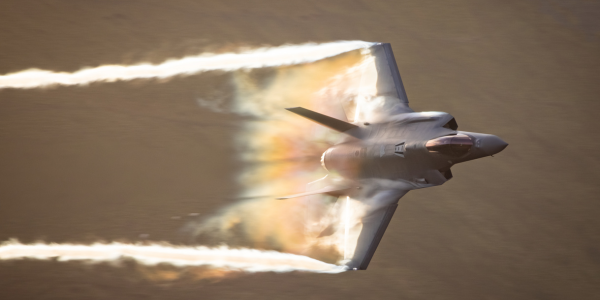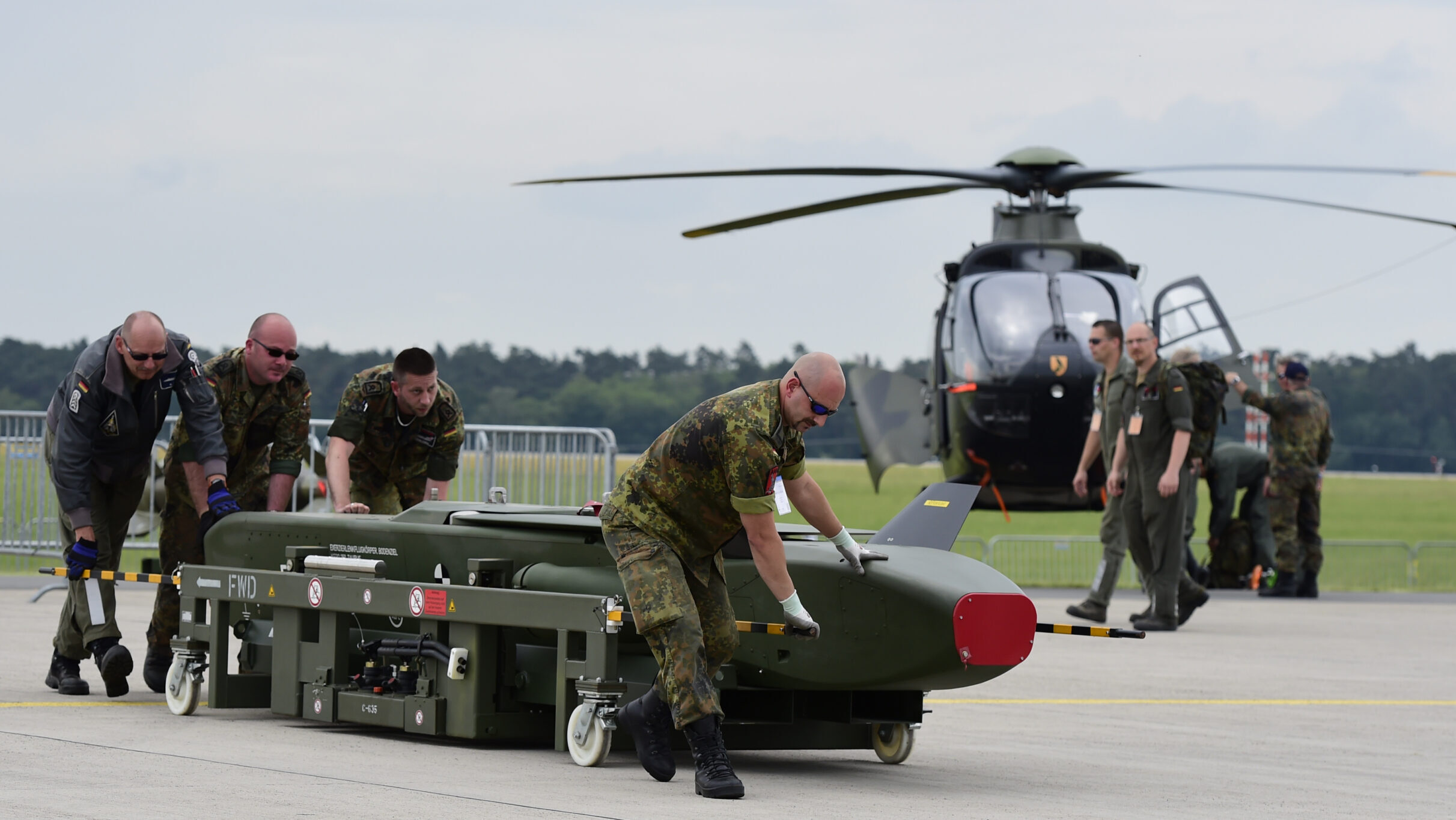Image courtesy of BAE Systems.
Lisa Aucoin is the vice president of F-35 Solutions at BAE Systems’ Electronic Systems (ES) sector. With more than 35 years of experience in the aerospace and defense industry, she has held numerous positions in engineering and program management. Previously, she was vice president of Engineering for the ES sector, leading more than 5,000 engineers and technical support staff. She is a certified Six Sigma Black Belt and holds a master’s degree in physics from Northeastern University, and a bachelor’s degree in physics from Valparaiso University.
Lisa is exceptionally passionate about developing our next generation of scientists and engineers and is actively involved with organizations that foster curiosity in science, technology, engineering, and math (STEM) subjects through active student participation.
We sat down to interview Lisa about electromagnetic warfare, the F-35 program, and her leadership.
You are the vice president of F-35 Solutions at BAE Systems. Can you describe your organization and its focus?
Lisa Aucoin, vice president of F-35 Solutions at BAE Systems’ Electronic Systems (ES) sector.
As a key partner on the F-35 program, we hold a 13 to 15 percent workshare of each aircraft, excluding propulsion, and we play a major role across multiple markets. I specifically lead the company’s F-35 program in the U.S. that has more than 1,000 employees dedicated to providing the electromagnetic warfare (EW) system for the F-35. As the EW system provider for the fifth-generation fighter, a role we’ve held since the program’s inception in 2001, we deliver a system that helps protect U.S. and allied forces.
For those unfamiliar with EW, simply put, it is the use of electromagnetic (EM) or directed energy and integrated cyber capabilities to carry out military and intelligence missions. The more rigorously a military force exploits the full EM spectrum –– radio waves, microwaves, millimeter waves, infrared, visible light, ultraviolet light, and gamma rays – and cyber effects, the more successfully it can pre-empt adversarial threats and respond to attacks electronically.
The system needs to detect threats and identify them, and give pilots the opportunity to evade or engage. These threats include other fighter jets, missiles, anti-aircraft systems, drones, and other adversary weapons systems. Everyday those threats are evolving, becoming more complex and harder to detect and counter as the electromagnetic spectrum grows more congested.
Our F-35 team is busy designing, developing, manufacturing, testing and repairing advanced systems that protect warfighters and enable them to conduct missions in highly contested battlespaces. Our people are highly skilled in disciplines including electrical engineering, mechanical engineering, software development, manufacturing, supply chain management, and program management. The program requires everyone to come together to deliver an exceptional technical system for integration into one of the most sophisticated fighter jets ever flown.
The AN/ASQ-239, the F-35 EW system, can detect a broad spectrum of electromagnetic signals in a 360-degree sphere around the aircraft at long range. This is done passively without emitting energy, making the F-35 less observable to adversaries. The systems’ “staring” sensors are embedded throughout the aircraft, providing immediate detection of electromagnetic signals, giving pilots critical situational awareness, and allowing them to act first. By delivering long-range, all-aspect (360-degree) broad-spectrum EW capabilities, the system also increases the probability of signal intercept.
BAE Systems has a long history in EW, how does the F-35 system fit into that portfolio?
Our EW history goes back more than 60 years and our systems have flown on over 120 platforms. They operate on 80 percent of U.S. military fixed-wing aircraft, over 95 percent of U.S. Army rotary-wing aircraft, and those of U.S. allies. The F-35 EW system is a key part of our extensive EW portfolio that includes protecting fighter aircrafts like the F-15, F-16, and the F-22 platforms.
What is the current status of the F-35 program and the EW system?
To date, 1,600 F-35s have been delivered around the world. Each aircraft is equipped with our integrated EW system. The F-35 is expected to stay in service until 2070 and was designed for continual upgrades to help it outpace emerging threats throughout its six-decade service life.
Recently, the F-35 platform achieved a significant milestone – it was cleared to enter full-rate production. As part of a broader strategy focused on whole-life mission effectiveness, the U.S. Department of Defense (DOD) entrusted BAE Systems to design and manufacture the next-generation “Block 4” version of the system.
The powerful Block 4 EW system will offer greater situational awareness, enhanced survivability, and increased capabilities to counter evolving threats. As an upgradeable system, Block 4 will combine adaptable hardware and incremental software updates to accelerate the delivery of advanced EW capabilities to warfighters. This will also reduce engineering and sustainment costs for the U.S. DoD and its allies.
Block 4 systems will include significantly advanced hardware and software that improve sensing and signal-processing capabilities. New, high-performance sensors will boost the system’s ability to detect more difficult-to-observe threats. It will help warfighters execute missions today and into the future.
What does success look like for you?
There are two primary ways we measure success – technology and operational milestones. These are driven by evolving mission requirements and the need to innovate.
Both types are important, but at the end of the day, it is about people –– our customers and our end-users. Protecting the warfighter is our north star. It really is what drives us. None of this would be possible without our people. We employ the best and brightest and we ask them to do very hard things.
We talked about our long history in EW, but looking forward, a platform like the F-35 is expected to fly for 60 years. So, to achieve this, it is about culture. We have always focused on our current workforce, but we know culture is a long-term strategy.
In many ways a focus on the future helps to drive today’s success. For example, the F-35 EW system was developed with the future in mind. Designed to be adaptable and upgradeable, it will be able to keep up with threats that haven’t been developed yet. It’s not a moment-in-time system, it is designed for the future fight, wherever that future leads.
You mention preparing for the future, how do you build your workforce for the future?
Internally, we have several leadership development programs for employees. Looking further into the future, we support STEM initiatives like FIRST® Robotics. BAE Systems has supported FIRST for 30 years –– working together to inspire students to pursue careers in STEM. The company provides funding to FIRST teams near ES sites nationwide, helps with robotics and coding grants for Boys & Girls Clubs, and funds an annual college scholarship program for FIRST students. We value this partnership because we believe FIRST is building the next generation of innovators.
Another element of building our future workforce is identifying and creating non-traditional entries into industry. One success story is our long-running Microelectronics Boot Camp program with Nashua Community College. The Microelectronics Boot Camp is a 10-week hands-on career training that was developed in partnership with BAE Systems in 2016 to prepare students for entry-level careers in wire/ribbon bonding and die attach for microelectronic components in manufacturing. The program recently celebrated its 30th cohort graduating class and has now graduated over 300 students with a 98 percent job placement rate –– with BAE Systems having hired more than half of these graduates.
Final thoughts?
Today’s F-35 system was built on the shoulders of giants. The technology leverages decades of innovation, lessons learned, and techniques and procedures cultivated over generations of an entire F-35 ecosystem and community.
Past employees influenced those working on the program today and we are cultivating the workforce of tomorrow to assure that we continue to serve our warfighters for generations to come.
At the end of the day, it is the history, the ecosystem, the focus on people and the future that drive me every day to come to work knowing I’m helping to safeguard generations of warfighters.










